Ask an expert: How can I get rid of head lice?


Summer means lighter mornings, hotter days and longer evenings - which makes it a brilliant time for kids to get outdoors, be active and enjoy the good weather. However, this also makes it the ideal opportunity for head lice to spread like wildfire, as children spend more time playing together.
While head lice are nothing to panic or be ashamed about (they're really very common), all parents should arm themselves with the facts and treatment methods, to make sure they know what to do if they spot one in their child's hair. Here, head lice expert Ian Burgess, director of the Medical Entomology Centre in Cambridge, shares his advice...
How can I tell if my child has head lice?


Advertisement
Hide AdAdvertisement
Hide Ad"Head lice can appear at any place and any time, so there is no need to avoid certain situations, but just be vigilant and ensure that you check your child's hair regularly. Some parents wait until their child starts to scratch, however, not all infestations cause an itching sensation.
"Firstly, to diagnose a case of head lice, you need to find them alive. Lice range in size from a full-stop to a sesame seed and they remain close to the scalp. However, you will need to check all over, from the back of the head to behind the ears and under the fringe."
Burgess suggests following the three Cs for tackling head lice:
1. Comb: Use a fine-tooth comb, with teeth no more than 0.3mm apart to ensure that you can trap them, and ideally use a white comb so they are more visible.
Advertisement
Hide AdAdvertisement
Hide Ad2. Conditioner: To ensure the process is as hassle-free as possible, try combing the hair when it is wet and use a conditioner as a lubricant. This will allow the comb to glide through easily without causing any fuss.
3. Comfort: As the process should be part of your weekly routine, make sure you child's comfortable and distract them with their favourite TV programme. This will ensure you can check for lice quickly and thoroughly.
What treatment should I use?
"If you find lice, don't panic; head lice are a normal part of life. You should use a non-pesticide treatment such as Hedrin Once Spray Gel (£6 for 60ml, Boots) that smothers the lice instead of poisoning them. Research suggests that lice have become resistant to traditional pesticide treatments, so they are less effective, although most people do use a non-pesticide product these days.
"Home remedies are sometimes used by parents, such as dosing the hair in vinegar, mayonnaise and olive oil, however, none of these are clinically proven to eradicate lice. If you are unsure about what treatment to use, speak to your pharmacist.
How do I ensure the treatment is effective?
Advertisement
Hide AdAdvertisement
Hide Ad"Remember: Only treat if you find live lice. Your pharmacist can advise on protection options if this is what you are looking for. It is very important to follow the instructions on the packet and cover the full length of hair until it is saturated for the recommended time. While ensuring the product is used thoroughly, it is important to keep it away from your child's eyes, face and shoulders and ensure you keep the lotion away from heat sources, such as hair dryers, naked flames and cigarettes."
Detect and protect
"Once you have completed the course of the treatment, you should check thoroughly to see if there are any live lice left - remember, you need to see them moving. If you do find lice, this could be a result of a failed treatment or a re-infestation. At this point, you will need to treat again and ensure that you follow the instructions carefully.
"It is likely that some of the empty eggs are left behind, as they have a strong bond with the hair and are difficult to remove - these are called nits. Previously, the removal process was done by hand or using a comb on dry hair, but ultimately this may cause hair breakage. There are now products available that help loosen the bond between the nits and the hair, to allow them to slide off easily when using a suitable comb. When you are confident that you have got rid of the infestation and the remaining nits, it may be worth considering a protection product as other children are likely to still be carrying lice in their class. Ask your pharmacist for more information."